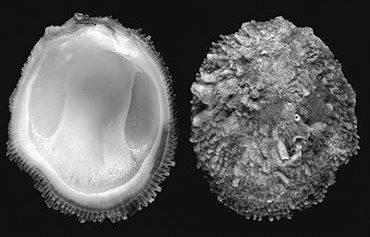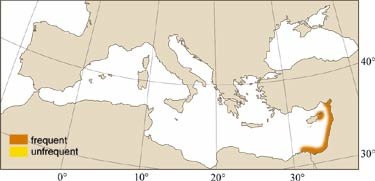
|
Relevant Synonyms
Misidentification
|
|
| photo: S. Gofas / Coll. H. Zibrowius |
|
SHORT
DESCRIPTION
color :
exterior white, red, orange or purple; interior white usually splashed with pale or deep rose, particularly round the margins.
common size :
up to 70 mm in height. |
DISTINGUISHING CHARACTERISTICS
BIOLOGY / ECOLOGY
habitat :
areas with little sedimentation; cemented to massive rocks in exposed areas, from the midlittoral zone to a few meters depth, attached to substrate by the left valve which is bigger; some individuals attach by the rv ("inverse form"). Off the coast of Israel, they share their habitat of bare, rocky outcrops of kurkar, a submerged aeolic sandstone, at depths of 12-15 m, with Spondylus spinosus. At depths 20-40 m, they form dense populations along with Spondylus spinosus, the surfaces of their shells providing strongholds for a diverse community of algae and invertebrates (Fishelson, 2000). |
|
1st
Mediterranean record
|

|
|
DISTRIBUTION
|
ESTABLISHMENT SUCCESS
speculated reasons for success :
|
|
|
MODE OF
INTRODUCTION |
IMPORTANCE TO
HUMANS |
|
KEY
REFERENCES
|
|
|
 Chama broderipi Reeve, 1846 [Tillier and Bavay, 1905]
Chama broderipi Reeve, 1846 [Tillier and Bavay, 1905]